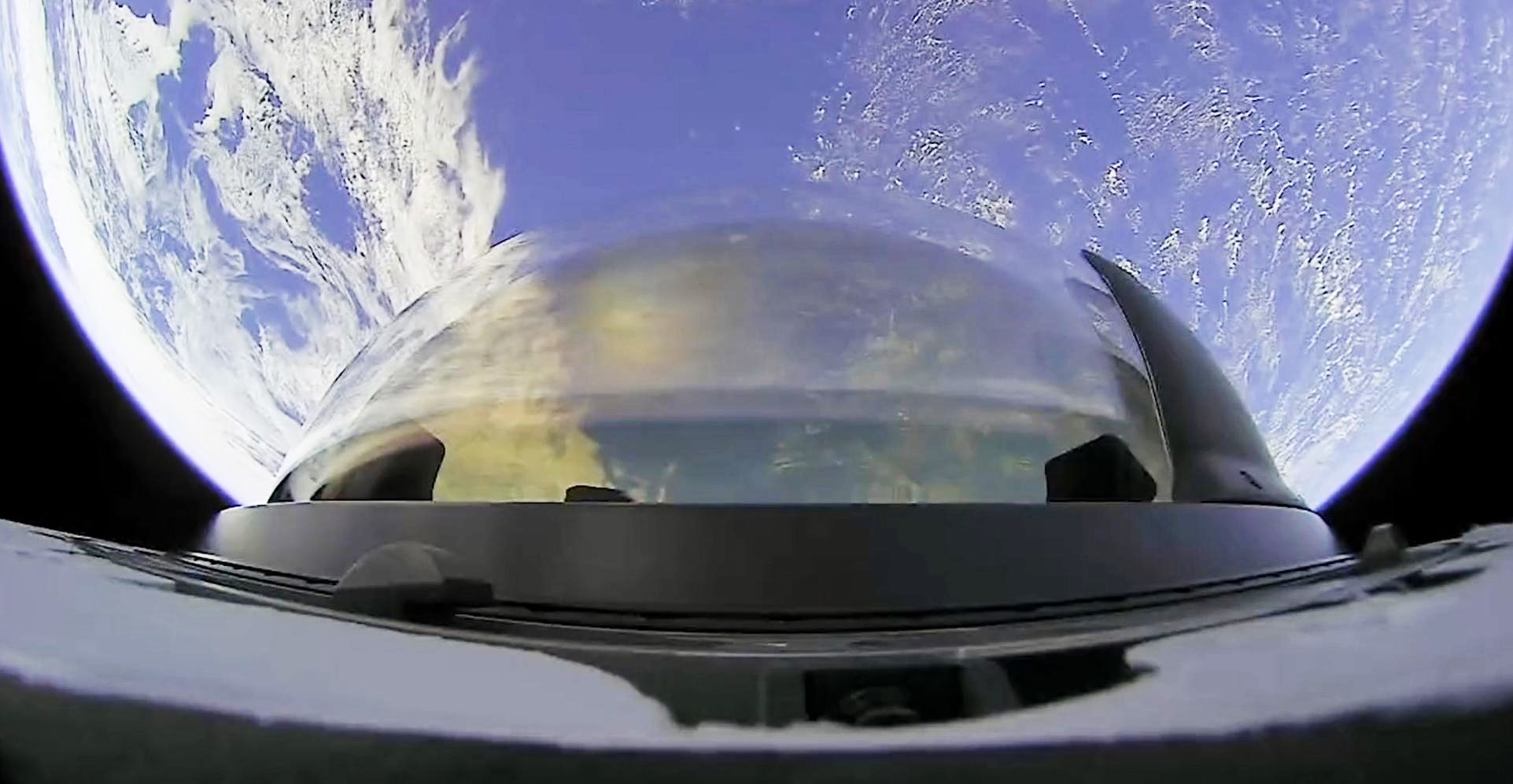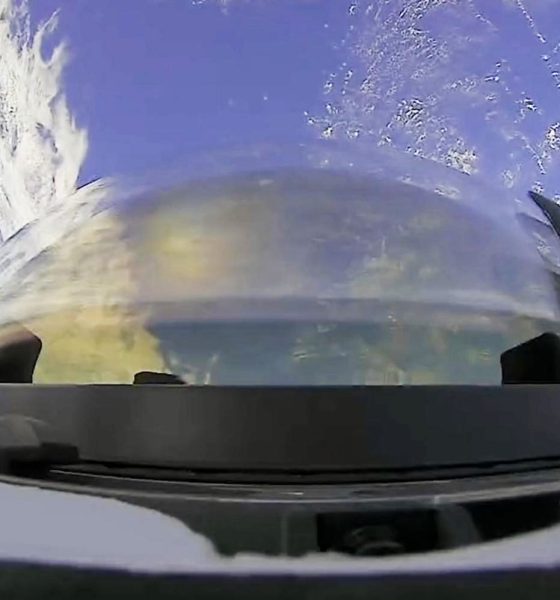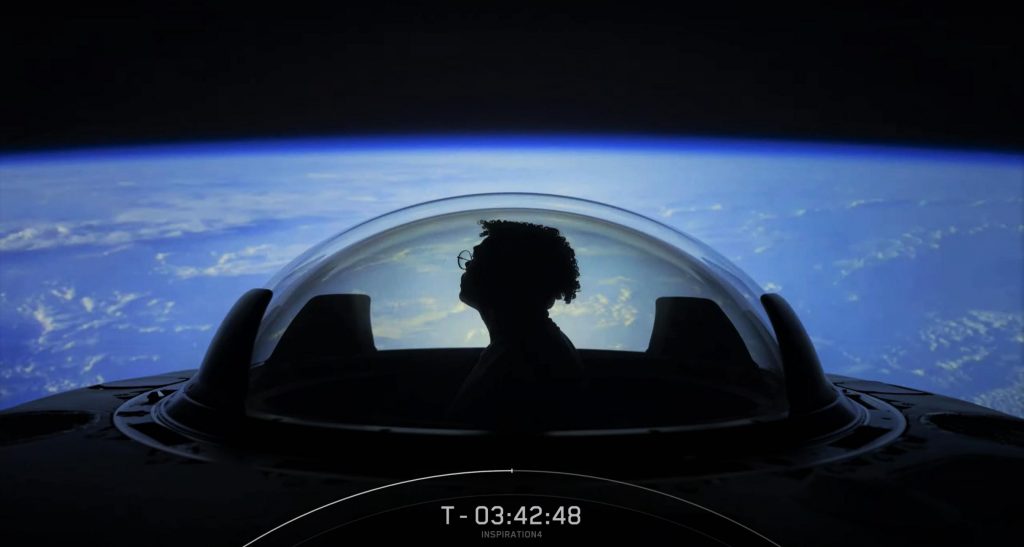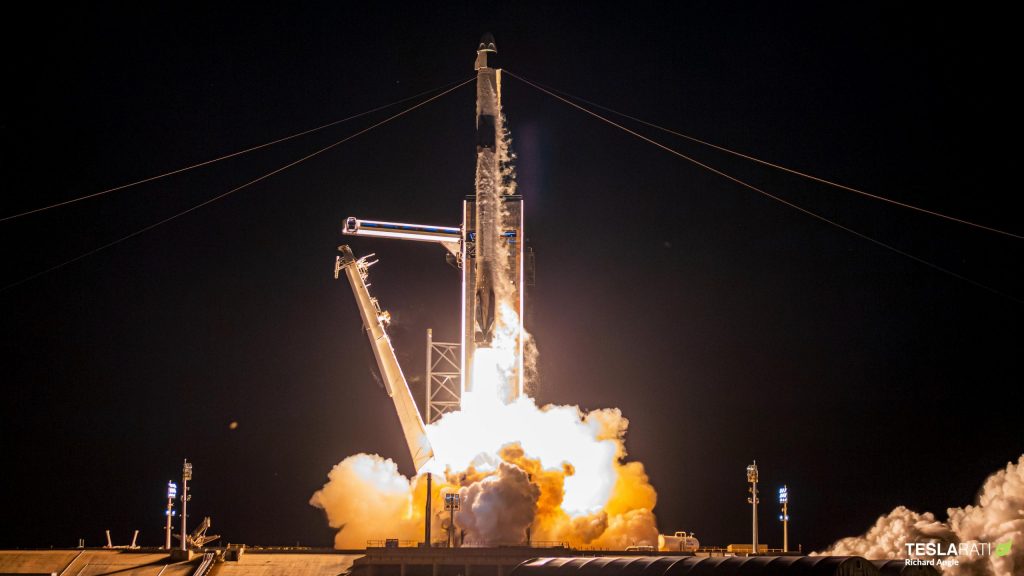

News
SpaceX shows off largest window in space after spectacular Inspiration4 launch
SpaceX has revealed the first on-orbit view of the largest window every launched on a rocket – and provided an update on the status of its first private astronauts – after Wednesday night’s spectacular Inspiration4 launch.
Around 8:03 pm EDT on September 15th (00:03 UTC 16 Sept), Falcon 9 successfully lifted off from Kennedy Space Center, sending four private astronauts – the world’s first all-private crew on an orbital spacecraft – into low Earth orbit (LEO). In the 18 hours since, now twice-flown Crew Dragon spacecraft Resilience has successfully boosted its orbit from around 200 km (~120 mi) to around 580-590 km (360-365 mi) – the highest altitude ever reached by private astronauts and highest any human has traveled in approximately two decades (19 or 22 years).
Now safely in orbit on what’s expected to be a three-day journey in space, SpaceX also reports that Inspiration4 commander Jared Isaacman, pilot Sian Proctor, medical officer Haley Arceneaux, and specialist Christopher Sembroski are all “healthy, happy, and resting comfortably.” As early as this afternoon, the four private astronauts will wake up and potentially experience Crew Dragon’s cupola – the largest window by surface area ever flown to space or orbit – for the first time.
Following a spectacular post-sunset launch and a nearly five-hour webcast covering it, many have noted that SpaceX and Inspiration4 have practically gone silent after reaching orbit and that unlike Crew Dragon’s past three NASA astronaut launches, there has been no live coverage – and virtually no news at all – of the in-space cruise phase. It’s quite possible that one, several, or all of the four Inspiration4 crew members – all spaceflight rookies – are experiencing the common and uncomfortable “space adaptation syndrome,” referring to extreme nausea and discomfort as many as two-thirds of astronauts experience during their first hours or even days in microgravity.
If that’s the case, it would be no surprise that the crew might want privacy for the first 12-24+ hours and more generally to simply enjoy being in orbit – and higher than all but a few dozen humans have ever traveled – with some degree of peace. A great deal of photos and videos are still expected – but as part of Netflix’s Countdown documentary and only after the crew returns to Earth, rather than the live, immediate coverage SpaceX’s other Crew Dragon missions have had.

With another two days left in orbit, the Inspiration4 crew are scheduled to perform a few relatively minor experiments – mostly focused on health – but are mostly expected to simply enjoy being in space. Once they wake up and are able to open Dragon’s forward bulkhead hatch, they’ll get to experience the first-ever views out of the spacecraft’s cupola. A camera inside the nosecone cover will allow them to take some truly unique self-portraits with Earth, space, and even the Milky Way as backdrops – only really comparable to the occasional self-portraits taken by astronauts during spacewalks.
With any luck, SpaceX or Inspiration4 will share a few of those special photos later today. Barring on-the-fly changes, the four private astronauts are scheduled to return to Earth on Saturday evening. Stay tuned for further updates on the historic mission.



News
Tesla starts showing how FSD will change lives in Europe
Local officials tested the system on narrow country roads and were impressed by FSD’s smooth, human-like driving, with some calling the service a game-changer for everyday life in areas that are far from urban centers.

Tesla has launched Europe’s first public shuttle service using Full Self-Driving (Supervised) in the rural Eifelkreis Bitburg-Prüm region of Germany, demonstrating how the technology can restore independence and mobility for people who struggle with limited transport options.
Local officials tested the system on narrow country roads and were impressed by FSD’s smooth, human-like driving, with some calling the service a game-changer for everyday life in areas that are far from urban centers.
Officials see real impact on rural residents
Arzfeld Mayor Johannes Kuhl and District Administrator Andreas Kruppert personally tested the Tesla shuttle service. This allowed them to see just how well FSD navigated winding lanes and rural roads confidently. Kruppert said, “Autonomous driving sounds like science fiction to many, but we simply see here that it works totally well in rural regions too.” Kuhl, for his part, also noted that FSD “feels like a very experienced driver.”
The pilot complements the area’s “Citizen Bus” program, which provides on-demand rides for elderly residents who can no longer drive themselves. Tesla Europe shared a video of a demonstration of the service, highlighting how FSD gives people their freedom back, even in places where public transport is not as prevalent.
What the Ministry for Economic Affairs and Transport says
Rhineland-Palatinate’s Minister Daniela Schmitt supported the project, praising the collaboration that made this “first of its kind in Europe” possible. As per the ministry, the rural rollout for the service shows FSD’s potential beyond major cities, and it delivers tangible benefits like grocery runs, doctor visits, and social connections for isolated residents.
“Reliable and flexible mobility is especially vital in rural areas. With the launch of a shuttle service using self-driving vehicles (FSD supervised) by Tesla in the Eifelkreis Bitburg-Prüm, an innovative pilot project is now getting underway that complements local community bus services. It is the first project of its kind in Europe.
“The result is a real gain for rural mobility: greater accessibility, more flexibility and tangible benefits for everyday life. A strong signal for innovation, cooperation and future-oriented mobility beyond urban centers,” the ministry wrote in a LinkedIn post.
News
Tesla China quietly posts Robotaxi-related job listing
Tesla China is currently seeking a Low Voltage Electrical Engineer to work on circuit board design for the company’s autonomous vehicles.

Tesla has posted a new job listing in Shanghai explicitly tied to its Robotaxi program, fueling speculation that the company is preparing to launch its dedicated autonomous ride-hailing service in China.
As noted in the listing, Tesla China is currently seeking a Low Voltage Electrical Engineer to work on circuit board design for the company’s autonomous vehicles.
Robotaxi-specific role
The listing, which was shared on social media platform X by industry watcher @tslaming, suggested that Tesla China is looking to fill the role urgently. The job listing itself specifically mentions that the person hired for the role will be working on the Low Voltage Hardware team, which would design the circuit boards that would serve as the nervous system of the Robotaxi.
Key tasks for the role, as indicated in the job listing, include collaboration with PCB layout, firmware, mechanical, program management, and validation teams, among other responsibilities. The role is based in Shanghai.
China Robotaxi launch
China represents a massive potential market for robotaxis, with its dense urban centers and supportive policies in select cities. Tesla has limited permission to roll out FSD in the country, though despite this, its vehicles have been hailed as among the best in the market when it comes to autonomous features. So far, at least, it appears that China supports Tesla’s FSD and Robotaxi rollout.
This was hinted at in November, when Tesla brought the Cybercab to the 8th China International Import Expo (CIIE) in Shanghai, marking the first time that the autonomous two-seater was brought to the Asia-Pacific region. The vehicle, despite not having a release date in China, received a significant amount of interest among the event’s attendees.
Elon Musk
Elon Musk and Tesla AI Director share insights after empty driver seat Robotaxi rides
The executives’ unoccupied tests hint at the rapid progress of Tesla’s unsupervised Robotaxi efforts.

Tesla CEO Elon Musk and AI Director Ashok Elluswamy celebrated Christmas Eve by sharing personal experiences with Robotaxi vehicles that had no safety monitor or occupant in the driver’s seat. Musk described the system’s “perfect driving” around Austin, while Elluswamy posted video from the back seat, calling it “an amazing experience.”
The executives’ unoccupied tests hint at the rapid progress of Tesla’s unsupervised Robotaxi efforts.
Elon and Ashok’s firsthand Robotaxi insights
Prior to Musk and the Tesla AI Director’s posts, sightings of unmanned Teslas navigating public roads were widely shared on social media. One such vehicle was spotted in Austin, Texas, which Elon Musk acknowleged by stating that “Testing is underway with no occupants in the car.”
Based on his Christmas Eve post, Musk seemed to have tested an unmanned Tesla himself. “A Tesla with no safety monitor in the car and me sitting in the passenger seat took me all around Austin on Sunday with perfect driving,” Musk wrote in his post.
Elluswamy responded with a 2-minute video showing himself in the rear of an unmanned Tesla. The video featured the vehicle’s empty front seats, as well as its smooth handling through real-world traffic. He captioned his video with the words, “It’s an amazing experience!”
Towards Unsupervised operations
During an xAI Hackathon earlier this month, Elon Musk mentioned that Tesla owed be removing Safety Monitors from its Robotaxis in Austin in just three weeks. “Unsupervised is pretty much solved at this point. So there will be Tesla Robotaxis operating in Austin with no one in them. Not even anyone in the passenger seat in about three weeks,” he said. Musk echoed similar estimates at the 2025 Annual Shareholder Meeting and the Q3 2025 earnings call.
Considering the insights that were posted Musk and Elluswamy, it does appear that Tesla is working hard towards operating its Robotaxis with no safety monitors. This is quite impressive considering that the service was launched just earlier this year.








